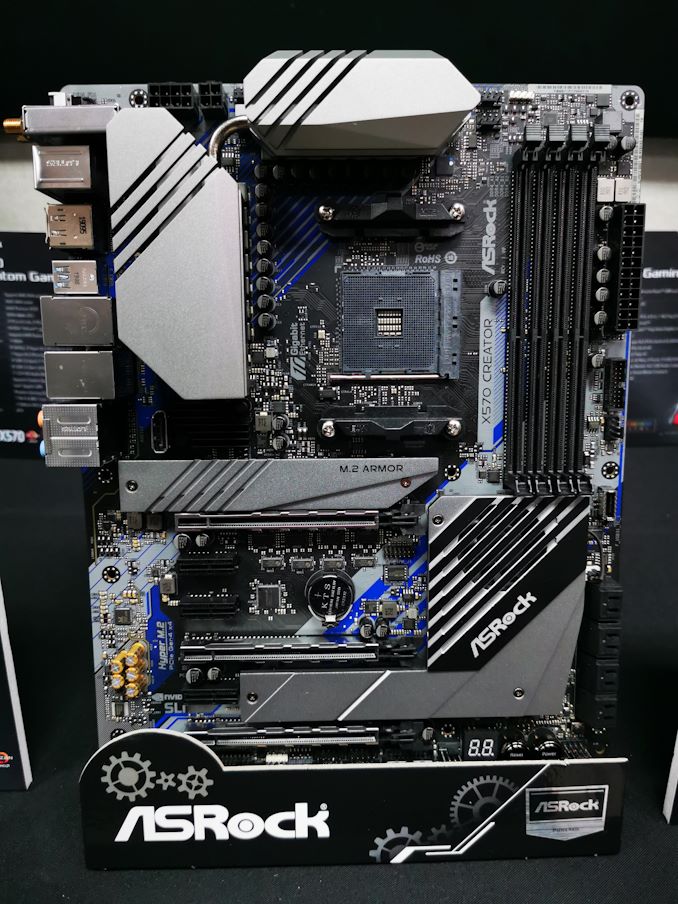The AMD X570 Motherboard Overview: Over 35+ Motherboards Analyzed
by Gavin Bonshor on July 9, 2019 8:00 AM ESTASRock X570 Creator
The ASRock X570 Creator is geared towards content creators with a similar feature set to the flagship ASRock X570 Aqua, but without the focus on high-end aesthetics, and water cooling. The X570 Creator has a simplistic and elegant theme with silver heatsinks, with black contrast.
Its X570 heatsink is actively cooled, and incorporates an M.2 heatsink, with a standalone heatsink for the top slot; the top M.2 slot supports PCIe 4.0 x4 and SATA, while the bottom slot is geared for just PCIe 4.0 x4 drives. For SATA there are a total of eight ports. On the PCIe front, there are three full-length PCIe 4.0 slots which run at x16/x8/x8, and x8/x8/x4, as well as three PCIe 4.0 x1 slots.
For memory, the ASRock X570 Creator has four slots with support for up to DDR4-4666 which remains to be seen if it will be effective or not in terms of performance. The X570 Creator also sports a 14-phase power delivery which is consistent with ASRock's other high-end offerings and has 8-pin plus 4-pin i12 V ATX CPU power inputs for delivering power to the processor. The feature set of the ASRock X570 Creator is similar to its other premium X570 models, but the main difference is primarily in the aesthetic. A cleaner, more professional look, without as much flash and pizazz. This mode has two PCIe 4.0 x4 M.2 slots, with a total of eight SATA ports with support for RAID 0, 1, and 10 arrays. A debug LED is located just below the X570 chipset heatsink, and next to these is an onboard power and reset switch.
With the ASRock X570 Creator being one of its more higher-end models, it has two rear panel Thunderbolt 3 Type-C ports. with an Aquantia AQC107 10 G LAN port, an Intel Gigabit port, Intel's AX200 802.11ax Wi-Fi 6 interface, and two USB 3.1 G2 Type-A, as well as four rear-panel USB 3.1 G1 Type-A. It also has two DisplayPorts with an input, and output, as well as one HDMI video output.
The ASRock X570 Creator comes in with an MSRP of $500 which for a premium feature set and everything on offer, it's not a bad price. There are other boards which cost slightly less with similar feature sets, but the Aquantia AQC107 10 G NIC, support for NVIDIA two-way SLI, and dual Thunderbolt 3 Type-C ports on the rear panel all add cost to the board.












225 Comments
View All Comments
DigitalFreak - Tuesday, July 9, 2019 - link
I think the only advantage of using a 2000 series CPU with an X570 board will be PCIe 3.0/4.0 support. The X370/X470 only supported PCIe 2.0. In theory, the connection from the 2000 processor to the X570 chipset should run at PCIe 3.0 speeds.FreckledTrout - Tuesday, July 9, 2019 - link
The x370 chipset and x470 both supported PCIe 3.0 with either a 1xxx or 2xxx Ryzen CPU. If you are not running a 3xxx CPU in the x570 board there isn't any major feature that should cause one to want to upgrade.DigitalFreak - Tuesday, July 9, 2019 - link
@FreckledTrout - Yes and no. The interconnect between the CPU and the chipset is PCIe 3.0 on X370 / X470, but all the PCIe lanes that come off the chipset are 2.0. Running a 2000 series CPU in an X570 board would give you a PCIe 3.0 link between the CPU and the chipset, with either PCIe 3.0 or 4.0 lanes coming off the chipset (depends on if AMD drops everything to PCIe 3.0 with a 2000 series processor).extide - Tuesday, July 9, 2019 - link
It looks like they still allow the chipset lanes to be 4.0. So you'd have 3.0 link to cpu, but 4.0 from chipset to devices.Targon - Thursday, July 11, 2019 - link
Since you have at least one or two PCI Express slots that are connected to the CPU, not chipset, that almost becomes a non-issue. On my Asus ROG Crosshair VI Hero(X370), you have PCI Express 3.0 x16 for the first slot, or x8/x8. The third PCI Express x16 slot is a 2.0 I believe, which is still enough to get the job done for many devices. Even with the X570 board with a first or second generation Ryzen processor, the most you end up with is an extra 3.0 supporting slot. Note that many boards may have x16 slots, but they are x8 electrically, so you won't see the full bandwidth anyway in those slots.sorten - Tuesday, July 9, 2019 - link
Thanks Gavin! This is a great resource and is exactly what I needed to help build my new system.willis936 - Tuesday, July 9, 2019 - link
The return of the 40mm fan! Those are the most obnoxious components ever. No one has missed them in the past ten years.Kastriot - Tuesday, July 9, 2019 - link
Buy Asrock aqua and problem solved.FreckledTrout - Tuesday, July 9, 2019 - link
I'm waiting for the next iteration of board for this reason. I'm speculating the next round the chipset will be on 7nm.abufrejoval - Tuesday, July 9, 2019 - link
The genious about that chiplet design is that the chipset doesn't actually benefit nearly as much from the shrink, as pure logic or SLC caches: The monolithic guys pay the 7nm overhead (e.g. EUV) for I/O while the geometry of the transistors in the I/O area is mostly determined by the need to power long motherbord or even slot traces.So while waiting is never a bad idea when your need clearly isn't overwhelming you, waiting for that shrink could turn out rather long. These days I/O heave chips might never be done in smaller geometries, because of that and because packaging has matured.